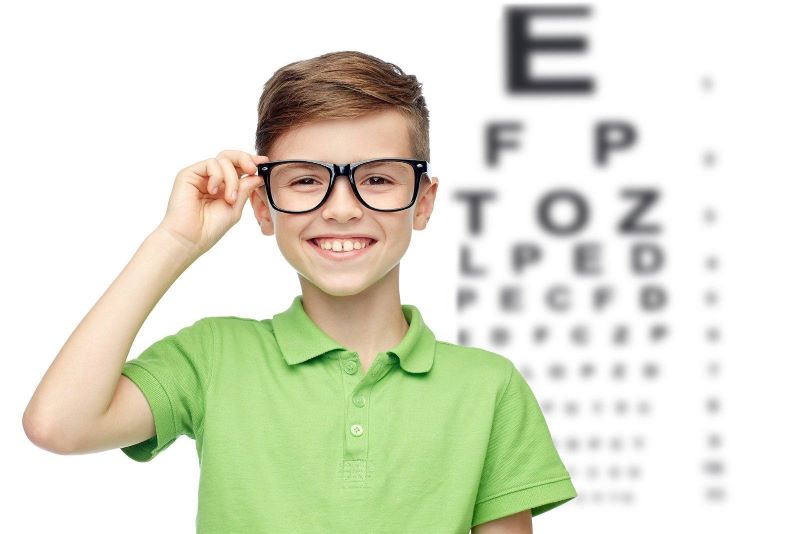How to reduce myopia naturally. Myopia is one of the most common refractive errors in the eye. In recent years, people with myopia also tended to increase rapidly. The cause may be due to the habit of working regularly with the computer, having to look at things at a close distance for a long time, and a very common cause that is due to genetic factors. The following article will help you learn about simple and effective ways to reduce myopia and limit the development of this condition.

Table of Contents
1. Myopia symptoms
Myopia is one of the leading refractive errors that reduce vision, the disease can progress over time, causing changes in the patient’s eye structure and increasing the risk of eye diseases later on.
1.1. Symptoms of myopia refractive error
When the eye is nearsighted, it is extremely difficult for the patient to see distant objects. Here are the most common symptoms:
-
Patients always have difficulty seeing distant objects, unable to clearly see distant objects.
-
Frequently squinting when observing things, especially distant objects.
-
Patients with eye fatigue, eye pain and pain when focusing too much on observation.
-
It is often difficult to see things at night.
Currently, children are the most common sufferers of diseases, which may be congenital or may be due to incorrect living and learning habits, or premature use of electronic devices, etc. affects eye health. Here are some symptoms of nearsightedness in children:
- Children have the habit of looking closely at the TV to see the picture clearly.
- When reading, children often jump or have to use their fingers to trace the words.
- In class, children have to get close to the board to see the words.
- Or write wrong words, lack of words when copying.
- Have a habit of bending down to look at books.
- When looking at distant objects, children often squint or have a habit of rubbing their eyes even when they are not sleepy.
- Children often have headaches and watery eyes.
- Or being dazzled and afraid of bright light.
- Children do not like to participate in activities that have to look far, …
1.2. Myopia classification
Myopia can be classified as follows:
Simple nearsightedness: Myopia is less than 6 diopters and may be accompanied by astigmatism. The disease occurs due to the unscientific working regime and can also be inherited.
Secondary myopia: Usually caused by fibrous conditions of the lens, as a side effect of certain medications, complications of diabetes, and many other causes.
Myopia at night: This is a condition in which the eyes lose sight in low light conditions. During the day, the eyes can still see things normally, but at night, the pupils will have to adjust more and if not treated early, the eyes will be deformed.
False myopia: This is a condition in which the accommodative ability of the eye is constricted and distance vision is temporarily impaired. After a period of rest, the eye will be restored.
Degenerative myopia: The degree of myopia of people with degenerative myopia is usually over 6 diopters, accompanied by retinal degeneration in the posterior part of the eyeball. The patient’s nearsightedness is increasing for the continuous lengthening of the eyeball axis. If not treated in time, the disease will seriously affect eye health.
2. Ways to reduce myopia
There are methods to help reduce myopia or limit the development of this disease. If myopia is too severe, it can cause early cataracts, even retinal degeneration and many dangerous eye problems.

2.1. Reduce myopia with eye exercises
Note that eye exercises do not help reduce myopia but will limit the increase and improve the health of your eyes. Especially those who often have to be in contact with and work with computers, they should do the following exercises to help their eyes relax and stay healthy:
Close your eyes: You close your eyes and rub the skin around your eyes for a period of one to two minutes, do it continuously for about 5 times. Another very effective eye-closing exercise is, you close your eyes for 5 seconds then open them wide for about 5 seconds. Repeat 7 to 8 times continuously for effective results.
Roll your eyes: If you have to regularly work on the computer, this is a very effective exercise. You sit comfortably and rotate your face clockwise about 5 times, then reverse the next 5 times.
Focused vision: Focusing on an object 6m away for 30 seconds without blinking. Rest for about 10 seconds, then continue looking at the object for about 15 seconds and then blink rapidly, continuously.
2.2. Reduce myopia by changing habits
Changing lifestyle habits more scientifically is also a way to help you limit the development of myopia. Because a common cause of this disease is unscientific work and study, the eyes must be overworked without proper rest. Follow these habits to protect your eyes:
Give your eyes a rest: After a period of stressful work, the eyes will be dry and sore, so it needs to rest and relax. Let your eyes rest for a few minutes after every hour of work.
Rinse your eyes with warm water to improve blood circulation and relieve stress. This is a very good habit for the eyes.
Stay away from electronic devices such as computers, phones 2 hours before going to bed.
Wearing glasses with the correct measurements: If you wear glasses with the wrong measurement, you are very likely to increase your degree.
Sit to work, study in full light conditions, sit properly, correct posture, should sit higher than the center of the screen.
Should provide enough nutrition to protect eye health, especially should eat a lot of foods containing vitamins A, vitamin C, calcium, chromium (brown rice, nuts, animal liver, …) , Zinc,…

Parents should take their children to regular eye exams to detect eye health problems early and treat them promptly. At the same time, you should choose reputable hospitals to ensure that your baby is examined and treated in the most effective way.





